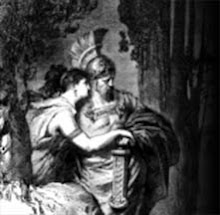Records of artistic expression appeared over 2 million years ago during the Stone Age. Statues of the Earth Mother Goddess of Africa and the cave paintings in France tell us what man valued and how he felt about those values. One Stone Age cave painting depicts the hunt. The subject attests to man's preoccupation with nature and his relation to it.
Following the Stone Age, we see the rise of higher political organization through conquest and the establishment of kingdoms. The art of the ancient Assyrians, Egyptians and Babylonians celebrate kings and their battles. Although this can be explained by the fact that only the powerful can afford an artist, we must also recognize that power has become the new great concern.
Simultaneous with the rise of civilization is the evolution of religion, another of man's greatest concerns. The history of religion describes man's reverence for his other worldly beliefs. As we would expect, the history of art shows the glorification of religious concerns with statues and painting portraying the gods and myths.
In the history of art, around 450 B.C., a new subject takes center stage. The place is Greece and the new subject is the natural man. Man is the measure of all things. Democracy is born. Not the king or his conquest, but the individual man is glorified. Even the gods take on human form. The human body is the object of beauty, new to the history of art, more natural in Greek art, more exaggerated in Roman art where muscular strength is a core value.
The art of the Middle Ages reverted to the motivations of the religious art of earlier times. Art is expressing man's greatest concerns. Not until the Renaissance does the natural, this worldly, man-centered universe return as man's greatest concern.
Modern art is still subject to wealth, to those who can afford it, but now it is the merchant, banker and the nobility that are glorified through art. The focus on the natural world reaches its apex in the realism of the 1800s. Evolving from realism, art begins to include man's subjective life and its part in forming reality, The Impressionism and Expressionism of the 1800s celebrates man's mental participation in reality, while the Abstract art and Surrealism of the 1900s shows man's valuation of the purely mental contribution of human mind to human reality.
Friday, February 22, 2008
Subscribe to:
Post Comments (Atom)




No comments:
Post a Comment